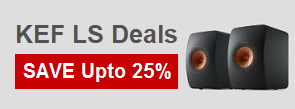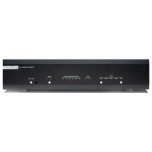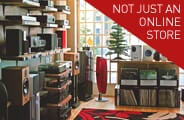DACs - Musical Fidelity
If you enjoy listening to music from your computer or portable player and want the best sound quality, you need a dedicated DAC (digital to analogue converter). In many cases, the soundcard or "headphones" output on your device is designed for cost rather than sound quality. By using a dedicated DAC, you bypass these and take the digital signal from your device. Many DACs include USB, as well as coaxial (RCA) and/or optical (Toslink) inputs for connection to other digital sources e.g. disc player, soundbar, etc. You can connect any of these DACs to your hi-fi amplifier or headphone amp, although if you're building a headphones system from scratch many of these DACs also include a dedicated headphones output. We also sell hi-fi streamers to stream directly from Tidal, Spotify, etc. Please contact us if you need help choosing.
Musical Fidelity presents best-in-class quality hi-fi components conceived from over thirty years of audio expertise. They design and engineer impactful hi-fi separates hosting excellent sound, high technical performance, exceptional value for money and remarkable build quality.
Musical Fidelity has designed and manufactured Hi-Fi electronics for more than thirty years and are among the best-known brands in the Hi-Fi industry. They aim to deliver exceptional music and tackle the challenge of world-class engineering. Each new design approach seeks the absolute best solution and embraces cutting-edge technologies as well as refining traditional methods for better performance.
Founder Antony Michaelson designed and produced his first amplifier, The Preamp, for his own home as he was frustrated by the mediocre preamp in his audio system. It was heard by an audio dealer who placed an order for some and they were so successful that they all sold over their first weekend on display. Consequently and almost by accident, Musical Fidelity was launched in 1982 and The Preamp received glowing reviews. It was then followed by the shoebox-style Dr Thomas power amp.
Over almost four decades, Musical Fidelity has introduced an impressive line of products from the A1 integrated amp in 1984, A370 Power Amp and Digilog; the World’s first high-end DAC. Their technologies were always at the forefront of the industry; The MVX preamp was the first in the world to combine tube circuit topology with transistors, the SA470 power amp ran 99% in Class in 1988 which facilitated the release of the A1000 four years later featuring pure Class A power amp section.
The 90s saw in the classic valve-driven Tubalog DAC, X Series with X-10D Class A triode line stage, X-ACT DAC and X-24K upsampling DAC as well as the
X-Ray CD player. The Nu-Vista Preamp employing compact, metal-cased nuvistor tubes sold out within three months of launch in 1997. These formed the basis for upgraded models like the futuristic CD-PRE 24 combining a high-quality CD transport/DAC/preamp and the Nu-Vista M3 pre/power amp with discrete Nu-Vista power amp modules and choke regulation.
The Tri-Vista series offered the world’s first audio application of trivistor tubes and the kW 500 super integrated amp employed twin-triode tubes. In 2003, Musical Fidelity released their first turntable; the limited-edition M1 which was regarded as one of the best-engineered decks then went on to become a collector’s item fetching above its original price.
The supercharged X-DAC V8 introduced switchable tube buffer and extra-heavy-duty power supply and the brand won their first EISA award with the X-150 (2004-2005) for European Stereo Amplifier of the Year. KW250S packs in dual 250-watt monobloc amps, tube hybrid preamp, phono stage, 24-bit 192K upsampling CD player, FM/DAB tuner and iPod input.
Titan, launched in 2009, is a 1kW p/ch twin monobloc design with external power supply alongside the Reference-standard Primo pure Class A pre-amplifier with 14 hand-picked ECC81 tubes. Their most recent additions aim to satisfy all budgets and hi-fi needs. These include the EISA award-winnng M1 CLiC which brings together analogue and digital sources, their finest digital AMS CD/DAC and the world’s most advanced pure Class A amp; the AMS100.
Now owned by an Austria-based independent specialist Audio Tuning, the brand retains its proud British heritage and preserves the natural authentic audio performance that has become synonomous with Musical Fidelity across the world. The unique product series accommodate traditional and contemporary requirements from high quality vinyl listening, bit-perfect CD playback or increasingly popular wireless music streaming. For each source, Musical Fidelity supplies a broad range of powerful, state-of-the-art amplifiers that sound at home anywhere.
Storing your music digitally, on a computer, laptop or NAS drive is now an incredibly viable and easy way of enjoying hi-fi quality sound, particularly with the prevalence of high quality FLAC and lossless files available. Using a good quality DAC can really make such digital audio sources an incredible way of enjoying your music, and in the case of high resolution files, can be essential to enjoy them at their full resolution and bit depth. With many high resolution files now exceeding the quality of CD, a quality DAC capable of playing such files enables you to enjoy stunning high-fidelity audio.
Many DACs offer a range of digital inputs, typically optical and coaxial, while some also feature USB functionality. Each input may have different capabilities in terms of the bit depth and resolution it is capable of playing. If you are looking to play particularly high resolution files via a certain input it is worth checking that the prospective DAC is able to play these. Some models will only offer 24bit/96kHz over some inputs, meaning that 24bit/192kHz files would not be able to play at their full rate. This only effects the highest quality downloads and audio files, and anything ripped from a CD will be stored in 16bit/44kHz, which most, if not all DACs are capable of playing.
When using your DAC via USB, many models now offer asynchronous USB connection. Unlike with a CD Transport, an asynchronous USB connection allows for the DAC itself to control the clock speed of the digital connection, which dramatically reduces jitter and ensures a high quality signal and sound. If you intend to use your computer or laptop as an audio source, asynchronous USB is definitely something to look out for. While many models feature a USB input, if the model you're looking at doesn't have this feature, you'll also need a USB to S/PDIF Converter if you want to use your computer via USB. This will convert the digital signal from your computer’s USB, and enable you to connect to the optical or coaxial input.
Once the DAC has converted the digital audio, it is outputted as an analogue signal, typically via RCA phono outputs which can then be connected to a pre amplifier or integrated amplifier. Some models offer alternative outputs, such as Balanced XLR which increase the range of connectivity options as well as the range of products which can be used.


















































































